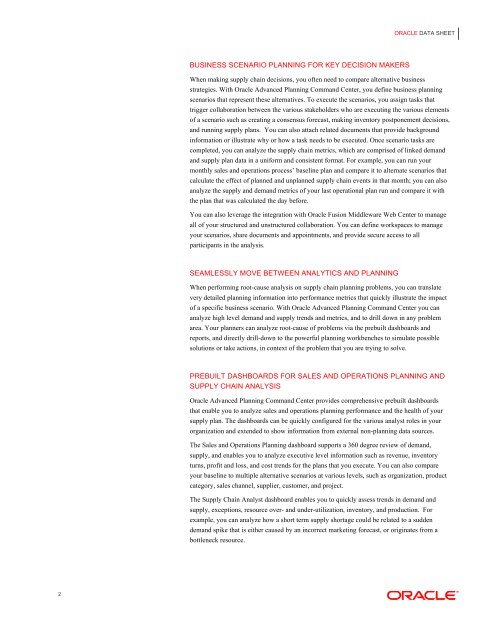advanced planning command center datasheet - Oracle
advanced planning command center datasheet - Oracle
advanced planning command center datasheet - Oracle
Create successful ePaper yourself
Turn your PDF publications into a flip-book with our unique Google optimized e-Paper software.
ORACLE DATA SHEET<br />
BUSINESS SCENARIO PLANNING FOR KEY DECISION MAKERS<br />
When making supply chain decisions, you often need to compare alternative business<br />
strategies. With <strong>Oracle</strong> Advanced Planning Command Center, you define business <strong>planning</strong><br />
scenarios that represent these alternatives. To execute the scenarios, you assign tasks that<br />
trigger collaboration between the various stakeholders who are executing the various elements<br />
of a scenario such as creating a consensus forecast, making inventory postponement decisions,<br />
and running supply plans. You can also attach related documents that provide background<br />
information or illustrate why or how a task needs to be executed. Once scenario tasks are<br />
completed, you can analyze the supply chain metrics, which are comprised of linked demand<br />
and supply plan data in a uniform and consistent format. For example, you can run your<br />
monthly sales and operations process’ baseline plan and compare it to alternate scenarios that<br />
calculate the effect of planned and unplanned supply chain events in that month; you can also<br />
analyze the supply and demand metrics of your last operational plan run and compare it with<br />
the plan that was calculated the day before.<br />
You can also leverage the integration with <strong>Oracle</strong> Fusion Middleware Web Center to manage<br />
all of your structured and unstructured collaboration. You can define workspaces to manage<br />
your scenarios, share documents and appointments, and provide secure access to all<br />
participants in the analysis.<br />
SEAMLESSLY MOVE BETWEEN ANALYTICS AND PLANNING<br />
When performing root-cause analysis on supply chain <strong>planning</strong> problems, you can translate<br />
very detailed <strong>planning</strong> information into performance metrics that quickly illustrate the impact<br />
of a specific business scenario. With <strong>Oracle</strong> Advanced Planning Command Center you can<br />
analyze high level demand and supply trends and metrics, and to drill down in any problem<br />
area. Your planners can analyze root-cause of problems via the prebuilt dashboards and<br />
reports, and directly drill-down to the powerful <strong>planning</strong> workbenches to simulate possible<br />
solutions or take actions, in context of the problem that you are trying to solve.<br />
PREBUILT DASHBOARDS FOR SALES AND OPERATIONS PLANNING AND<br />
SUPPLY CHAIN ANALYSIS<br />
<strong>Oracle</strong> Advanced Planning Command Center provides comprehensive prebuilt dashboards<br />
that enable you to analyze sales and operations <strong>planning</strong> performance and the health of your<br />
supply plan. The dashboards can be quickly configured for the various analyst roles in your<br />
organization and extended to show information from external non-<strong>planning</strong> data sources.<br />
The Sales and Operations Planning dashboard supports a 360 degree review of demand,<br />
supply, and enables you to analyze executive level information such as revenue, inventory<br />
turns, profit and loss, and cost trends for the plans that you execute. You can also compare<br />
your baseline to multiple alternative scenarios at various levels, such as organization, product<br />
category, sales channel, supplier, customer, and project.<br />
The Supply Chain Analyst dashboard enables you to quickly assess trends in demand and<br />
supply, exceptions, resource over- and under-utilization, inventory, and production. For<br />
example, you can analyze how a short term supply shortage could be related to a sudden<br />
demand spike that is either caused by an incorrect marketing forecast, or originates from a<br />
bottleneck resource.<br />
2

















